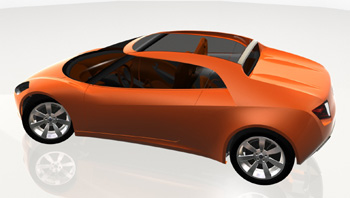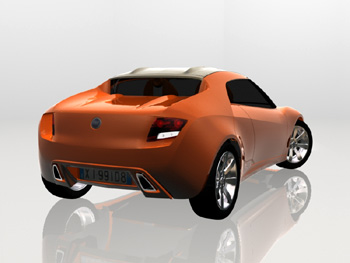The
Istituto Europeo di Design (IED) of Turin will be present at
the Geneva International Motor Show this March. The Geneva
show has become a regular event for this outstanding
transport design institution.
The
IED has chosen this exclusive venue to unveil their 'X 1/99'
concept car, the work of Master RSP students following the
famous Transportation Design course. The project was
realised during the 2003-2004 academic year in collaboration
with Fiat Auto and Webasto under the theme of "Work
Experience".
For
two years the IED, with this presence in Geneva, has held
the record (together with Espera Sbarro) of being the only
school in the world to take part in
such a renowned motor show, as well as the only one to
produce a model in real scale, the greatest achievement of
the Institute’s planning resources.
As the 'X 1/99' name
suggests, the concept has been developed on the new Fiat
Punto platform (Progetto 199), and has a 4.064 mm length,
1.790 mm width, 1.293 mm height, and a wheelbase
of 2.570 mm. The students were led throughout the project by
Lowie Vermeersch, designer at Pininfarina and Coordinator of
the IED Master's Degree. Alongside Vermeersch was Michael
Robinson, from Fiat Brand Promotion, and Gianni Firgatti,
from Fiat Marketing.
The proposal is a coupé-cabriolet
style car, with 2+2 seating, sporting pretensions, a highly
versatile design, aimed at a dynamic audience and combined
with both inner- and outer-town driving qualities. It is a
professional vehicle, with obvious characteristics
overlapping from both the B and H segments: practicality, an
accessible price, unique appeal, and a diverse design
being joyful to own. A
car therefore that induces potential customers with the the desire
to own it.
The
name of the car intentionally recalls Fiat's X 1/9 sportscar
from the '70s, with the classic model providing the point of
departure in the students' design brief.
|
 |
Developed
in collaboration with Webasto, the 'X 1/99' presents
a new concept of removable hardtop roof design.

|
|
|
 |
Combining
elements from both the B and H segments, the 'X
1/99' concept is based on the future Fiat Punto
platform.

|
|
|
The project develops an innovative concept of a transformable car, this being one of one of the most followed trends at the moment by major car manufacturers. 'X 1/99' proposes a multifunctional sun-roof, which has been developed in conjunction with Webasto, world-leader in opening roofs, and Cecomp - the prototyping house, responsible for, amongst other projects, the realisation of the highly acclaimed 2003 Lancia Fulvia Coupé concept .
This IED-Fiat concept car is therefore accompanied by new
conceptions and characteristics, which is further evidence
to the open
approach of this Turin-based company. In fact it is paying
more and more attention to innovation, style and, last but
not least, ideas developed by young minds, with the aim of
promoting what Fiat Auto always wants to be known as: “A
car manufacturer with a fresh and lively style, expressed
through Italian design and ingenious creations which make
life easier.”
'FUNction'
has been the key word in the development of all the
students’ planning suggestions. “Since
the beginning the project has been based on a single
conception," the students of the Master’s say unanimously, "a
basic idea that we like to sum up with this thinking: fun and function should be one.”
These
are the main characteristics of the concept car, the
culmination of a
project started in March 2004 which has been developed
through various
stages: briefing to the students by Fiat (March 2004); a research stage lasting for about two months and aimed at
defining the project target more accurately; the beginning of
the planning stage; a presentation to the commissioner of
seven proposals with reference to concept and package (end
of June 2004); advanced presentation of seven models in clay
with a scale of 1:5 (mid-October 2004); selection of two
models out of seven, on which the students, divided into two
teams, worked until the final project was chosen (beginning
of November 2004).
Continued
on Page 2 >
Page
1/2 |
|
![]()
![]()